Tower Wars from SuperVillain Games is not the first attempt at a versus tower defese game, but, despite a few rough spots that could use some polish, it’s the first to really get it right.
Here’s how it works:
First, you need to know there is no single-player version of this game. It’s not a standard tower defense game which has a ‘versus mode’—there is a single-player tutorial, but there is no real AI: it’s just a sequence of events designed to teach the mechanics. Instead, it was built from the ground up with the intent of being for multiple players against one another, and I think this is a big part of why it’s so successful. The other part is the split resources, but I’ll get to that in a moment.
Each map is divided into two sides, which mirror one another, and each has a castle and a barracks. The barracks is pointed at the opposing side’s battlefield, and the castle is at the back of that battlefield. Players have to spend their resources on building towers to defend against the units coming from the enemy barracks, building their own units to send out into the opponent’s battlefield, purchasing new unit options for their armies, buying upgrades for the castle or units, and upgrading thier gold mines to increase gold production. Balancing these expenditures is key to success.
There are 8 towers to choose from, each of which have their own unique role on the battlefield and a clever name. They are placed and upgraded by use of a radial menu that takes a bit of getting used to, but becomes pretty quick and intuitive after a few games—everything else in the game is just controlled with GUI buttons or keyboard shortcuts. The battlefield is open-grid style, so players are building a ‘maze’ for enemy units to navigate, rather than having to just line an existing route with towers. This, combined with the random obstacles on the board, means that—despite only shipping with three maps to choose from—each match will require a new tactic of placement. No need to have to keep track of the path in one’s head however, as the UI tells each player exactly what the current path through their maze will be.

A dotted line shows the enemies most efficient path through your towers. Also note the gold mine obstacle.
There are 10 unit types which can be combined into armies and sent into enemy territories in waves. These waves must be separated by at least half a minute (45 seconds at the start of the match, but upgrades can shorten the timer), and are limited in their size and composition, with more powerful units costing significantly more and taking up more space in the size limit. The units are just as diverse as the towers, and represent a wide variety of possible tactics.
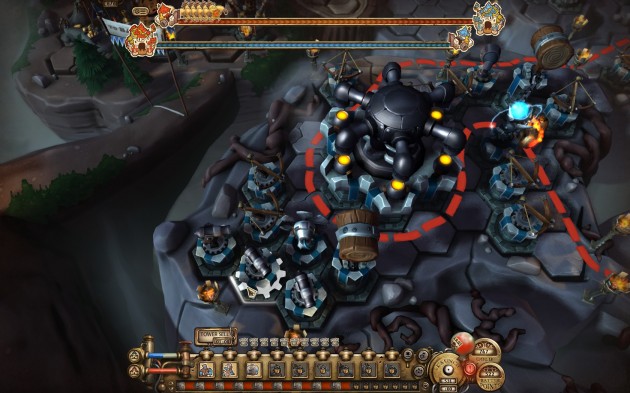
The most difficult tower to use tactically—but also most effective when placed properly—takes up seven hexes and damages only enemies who walk past it.
One cannot simply build up to a massive best-army-ever and send it over for the win, however. The game is balanced such that you must send waves as often as possible, and they will start with just a few of the most basic units (with no chance to succeed). It gets progressively more difficult so that each player is responding to a ramping wave difficulty similar to a standard tower defense game. This is accomplished by the split resources I mentioned a few paragraphs up. Each player has two resources to work with: ‘Gold’ and ‘Battle Points’. Each is only earned in one way, and both are needed for victory. Gold is farmed from the gold mines on the map (which are also the randomly placed obstacles). Upgrading the gold mines delivers more gold/second. No gold is earned from killing enemy units, or any other way; the mines are the only source. This resource is used primarily for building towers and hiring armies to send out.
Battle Points, however, are earned only from sending out units. The more time one’s units spend in enemy territory, the more BP one earns. This is the only way to earn BP, so there is a need to be constantly sending out units, even if you know that they can’t succeed. It also means that most players set up their towers starting at the entrance to the battlefield and working back toward the castle, to deprive the opponent of as much BP as possible. The BP is used mostly in upgrading things. If one wants more defenses at the castle, more unit types to choose from for armies, more gold/second at the gold mines, or any of the unit upgrades—like more health, speed, armor, etc.—they need BP. Some of these also require some gold, but all of them require BP. These economic mechanics go a long way toward balancing the matches, and also toward making it feel more like an actual tower defense game.
Games are started either by setting up manually and inviting friends, or by letting the game find a ‘ranked’ match for you. Either way, you could end up a member of a team of 1-3 players. The game supports six players, but never more than two teams.
All of these core mechanics come together to make a generally well-balanced game with little down time, and plenty of tactical options. The matches are always perfectly balanced, and very rarely go so long that they get tedious. Neither is there a single definer of victory; there is no particular unit or upgrade which, once purchased, means assured victory. As icing on this already phenomenal cake, all the levels are hex-based grids, which as any tactical gaming fan knows, is far superior.
The artwork, for its part, is colorful and amusing without being distracting or too full of particle effects. It has a Victorian sensibility to the level and unit design which makes it feel a bit steampunky, but it’s not overdone. This combines with the clever naming conventions—the ‘grunt’ unit is called ‘Mr. Moopsy’, and the Tesla-esque shock tower is called ‘Voltaic Liberation Apparatus’, for example—into a quirky atmosphere which never takes itself very seriously.
Problems?
So where are those blemishes I mentioned? They are thus:
First, a niggle. The sound could use more refined controls.There is some limited voice acting in the game, and while it is not poorly performed, it is a little repetitive after a while, and on about my fourth game, I went searching in the options for a way to at least turn down the voices. There was no distinct ‘voice’ volume though, so losing the voice sounds meant losing all the sound effects. It’s not a big deal, but it seemed strange not to have the option, since it’s become pretty standard in modern games to have more refined sound control options.
The rest of my issues only crop up in the co-operative mode. Team work in the co-operative mode is not intuitive, and having a teammate makes the game more difficult to coordinate, even with good communication, which one rarely gets except when playing with friends. That part is likely not news to you. Any one who has ever played a team-based game in which strangers are potentially your teammates understands that, most of the time, you just don’t get people who want to chat with you and coordinate. That makes it tough enough, but here, even if you can coordinate, there is not much coordination to be done. I was expecting that my teammates and I would be able to delegate responsibilities for the team. One person build towers, while the other sends waves of steam-powered knights, but this doesn’t happen here. Each player has their own ‘team’ in a sense. They have their own unit upgrades, their own towers, their own pools of resources, even the upgrades made in the Armory are not shared among teammates. The only upgrades teammates share is to the goldmines. This means that everyone has to do their own upgrades, which means everyone has to have BP, which means everyone must send waves of units, and no one can really focus on only one thing. Everyone has to do all things. Players cannot even upgrade each others’ towers, which seemed particularly counter-intuitive to me.
The worst part of the co-op mode, however, was something rather mundane and which should have been discovered early in their playtests. Two of the colors look too similar. On the red team, the three player colors are pretty distinctive, but on the blue team, the first two players are colors that I can only call blue and off-blue (the third blue-teamer is purple, and that’s fine). In any game in which I was the first or second player on the blue team (which seemed like most of the time) I would quickly get frustrated that I could not tell at a glance exactly which towers were mine, and which were my teammate’s. This, combined with the inability to upgrade my teammates’ towers, meant I was on a constant scavenger hunt for which towers in the globs of towers were my towers, so that I could interact with them.
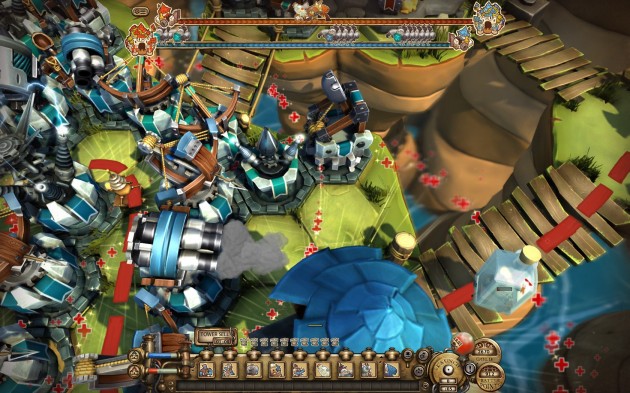
The best way to tell the differnce between these two banner colors is to note that one is tapered and the other is forked. In the heat of battle, that's not fast enough, especially since one cannot always see the base of the towers, and must go by the colors on the firing device alone.
As I said, though, despite these few small blemishes—which mostly could be fixed with a quick patch—the game is an excellent representative of the genre. In fact, I’m willing to call it the first true entry in its genre. Tower Wars is the paragon of the ‘vesus tower defense’ game, and will be the yardstick against which I measure future entries in the field. I wont be surprised if we start to see the basic formula used here in many new games over the next few years.
Everyone who enjoys tower defense games at all needs to pick this one up.
Tower Wars is available now on PC through Steam for $8.99.



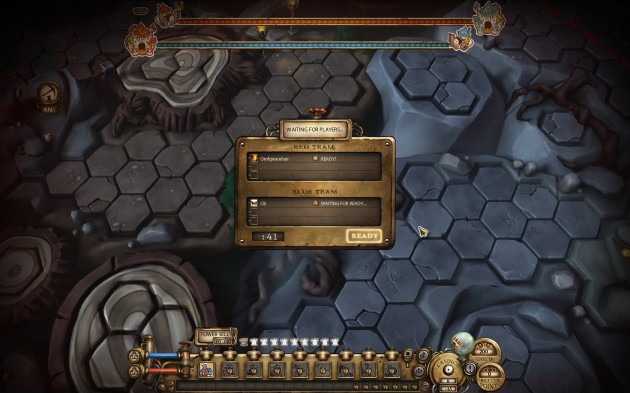

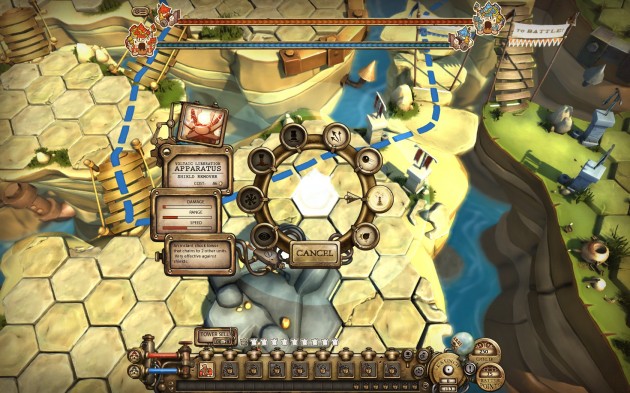
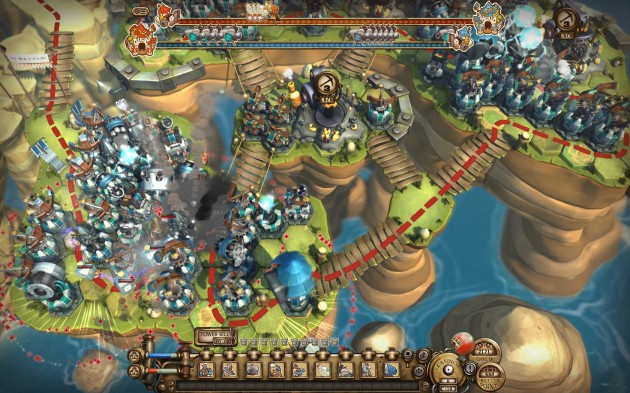








 Articles RSS
Articles RSS